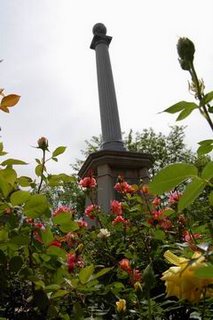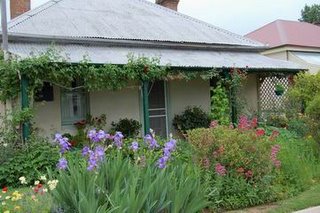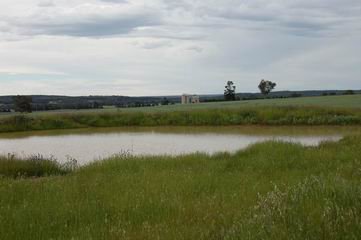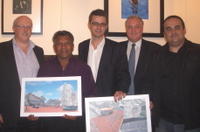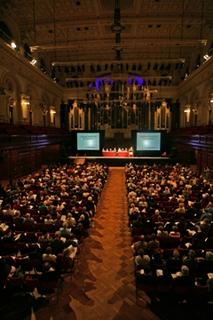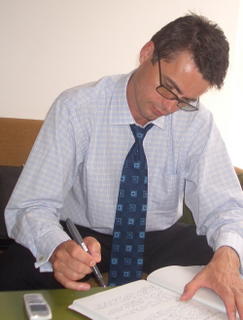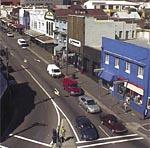 Council's multi million dollar granite-fication of the suburbs continues with the plans for the upgrade of the Redfern 'village' well advanced. The Council's project web site promises:
Council's multi million dollar granite-fication of the suburbs continues with the plans for the upgrade of the Redfern 'village' well advanced. The Council's project web site promises:
The Redfern Street Upgrade project aims to provide a more vibrant, active and safe public domain through the implementation of urban design improvements. The upgrade will deliver better visual amenity, enlivened retail activity and a pedestrian/bicycle friendly environment. The works will also create a strong and clear streetscape identity and reclaim Redfern Street as the backbone of Redfern.
Scope: The original scope of the works was Redfern Street, from Regent to Elizabeth Street. However, the project scope has been extended to include the expansion of Jack Floyd Reserve and some localised works for Regent Street.(see Council's plans here).
Just when you think that the City's attitude to providing equitable and genuine bike riding facilities had turned the corner after the debacle on Oxford and William Streets (read about them here) we are yet again confronted with the attitude that when something has to be given up its the bike facilities that go! This time the bike user groups and the Councillors that support them (including this one) have worked hard to protect the inclusion of bike facilities in this upgrade to one of Sydney's most bike friendly communities. We have already accepted a compromise on bike lanes. The compromise agreed to is the provision of a dedicated bike lane on one side only (that being between parked cars and traffic) and the combination of traffic and bike lane on the other. The lesson here for negotiators is not to make any compromises too early because you are immediately tagged in a weak position for future negotiations.
 Late last week news spread fast amongst the bike community that Council staff had revised the upgrade plans and had decided to recommend the scrapping of bike lanes altogether and the transfer of bike routes off Redfern Street and onto two parallel side lanes. This is apparently to enable a further widening of the footpaths by approximately 60cm (excuse the general nature of the information but no written reports have been provided). This is on a street where pedestrians fear to venture and shop keepers use roller shutters to protect their investments.
Late last week news spread fast amongst the bike community that Council staff had revised the upgrade plans and had decided to recommend the scrapping of bike lanes altogether and the transfer of bike routes off Redfern Street and onto two parallel side lanes. This is apparently to enable a further widening of the footpaths by approximately 60cm (excuse the general nature of the information but no written reports have been provided). This is on a street where pedestrians fear to venture and shop keepers use roller shutters to protect their investments.
Council yet again fails to acknowledge the benefits that bike users bring to a streetscape. We all acknowledge the benefits do not happen overnight but as facilities and networks develop and grow and community attitudes change we will see the economic, social, health and environmental benefits accrue. The promised benefits of any streetscape upgrade are slow to develop. For example the Darlinghurst Road upgrade (without bike lanes) has not kick started the great urban revival as promised. Oxford Street will be anoter slow recovery.
A reminder on the opportunities and benefits that bike lanes and facilities will provide for Redfern Street:
- Bike facilities should be treated with equity with other transport facilities eg pedestrians, cars, public transport.
- Bike facilities should not be hidden from mainstream routes and public view as their presence and growing use help to further promote sustainable and active transport options.
- Studies show that bike lanes and users are highly beneficial for local businesses.
- Bike lanes and users help to reduce social isolation and add to passive surveillance and street safety.
- Bike lanes and users add to community fitness, health and help reduce early mortality.
- Bike lanes and users encourage children to be more fit and active and help create safer streets for them to live on - even if they do not ride a bike.
- Bike lanes reduce exhaust emissions and pollution levels and therefore make the streetscape more pleasant and healthy for all users.
Councillors were briefed on the proposed changes on Monday afternoon. Two Councillors, myself and Chris Harris spoke out against the changes citing the arguments outlined above. Staff insisted that the changes were still providing facilities and options for bike users. It was the pea and shell argument. They could ride in the traffic on Redfern Street or if less confident take the side lanes along with the garbage trucks and laneway refuse. It seemed that some staff and Councillors were putting the case that it was bike lanes or trees, bike lanes or pedestrian space. The outcome is that staff will come back to the Councillors with options and more detailed assessment of the proposals.
Bike riders and user groups should continue to strongly lobby the Councillors to oppose the amendment to move bike lanes and facilities from Redfern street to side lanes.
email your Councillors:
Clover Moore mailto:cmoore@cityofsydney.nsw.gov.au
John McInerney mailto:jmcinerney@cityofsydney.nsw.gov.au
Marcelle Hoff mailto:mhoff@cityofsydney.nsw.gov.au
Robyn Kemmis mailto:rkemmis@cityofsydney.nsw.gov.au
Phillip Black mailto:pblack@cityofsydney.nsw.gov.au
Michael Lee mailto:mlee@cityofsydney.nsw.gov.au
Tony Pooley mailto:tpooley@cityofsydney.nsw.gov.au
Verity Firth mailto:vfirth@cityofsydney.nsw.gov.au
Chris Harris (supportive) mailto:charris@cityofsydney.nsw.gov.au
Shayne Mallard (supportive and copy) mailto:smallard@cityofsydney.nsw.gov.au
Come along to the public meeting to discuss the upgrade:
Community Meeting
Redfern and Regent Street Upgrade
Wednesday 2 November 20056pm – 7.30pm
Redfern Town Hall73 Pitt Street, Redfern


